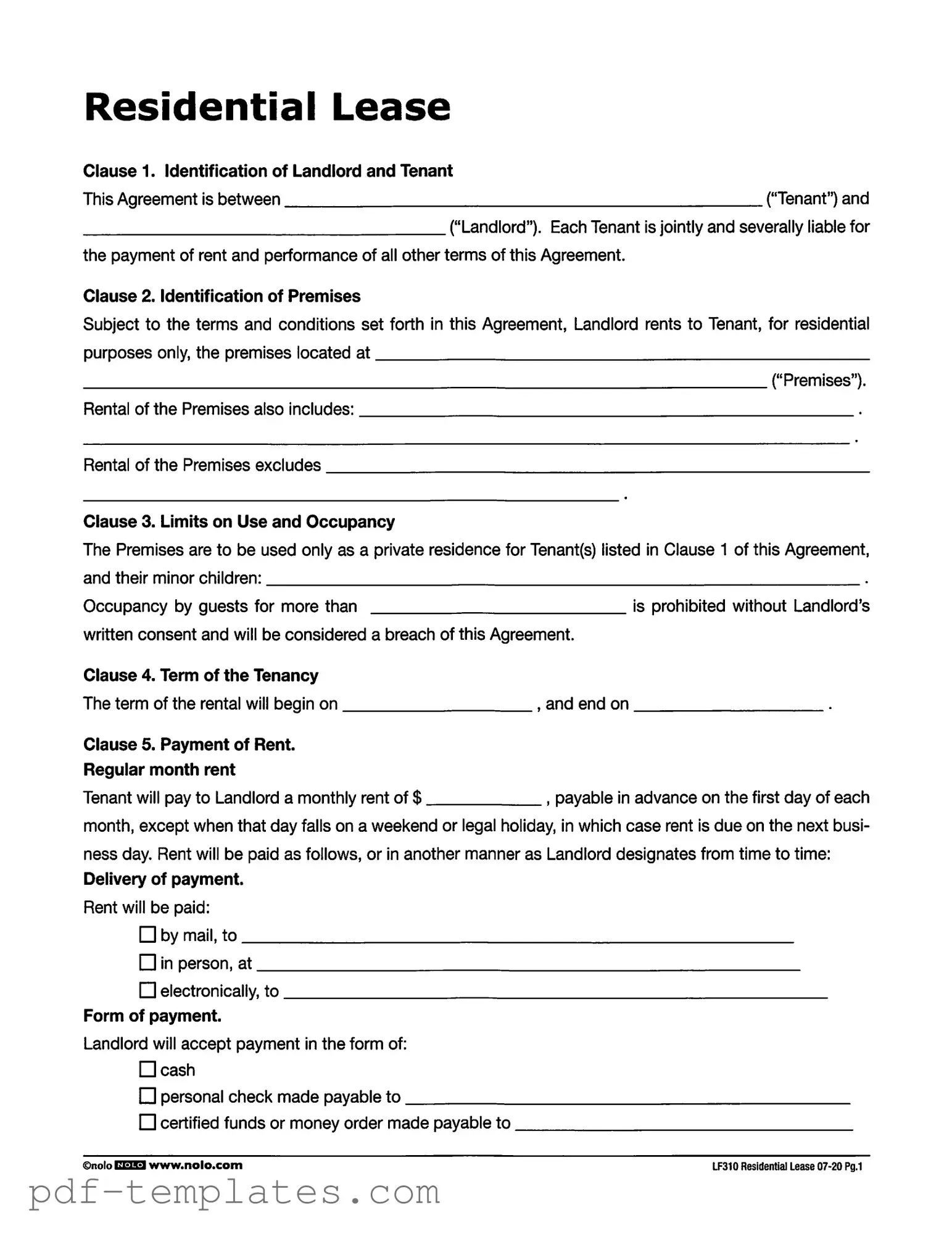The LF310 Residential Lease form shares similarities with the standard Apartment Lease Agreement. Both documents outline the responsibilities of landlords and tenants, including the identification of the parties involved and the premises being rented. They specify the terms of the tenancy, including the duration and payment of rent. Additionally, both agreements typically include clauses about late fees, security deposits, and restrictions on subletting. This ensures that both parties are clear about their obligations and rights throughout the rental period.
Another document akin to the LF310 form is the Commercial Lease Agreement. While primarily used for business purposes, it also includes sections that detail the identities of the landlord and tenant, the leased premises, and the payment terms. Both agreements cover the consequences of late payments and outline the conditions under which a tenant may sublet or assign their lease. However, the commercial lease may have additional provisions related to business operations and zoning compliance.
The Roommate Agreement is another document similar to the LF310 Residential Lease. This agreement is particularly useful when multiple tenants share a rental property. It addresses the identification of all roommates and their respective responsibilities, including rent payment and utility costs. Like the LF310 form, it may include clauses about the use of the premises and restrictions on guests. This helps to prevent misunderstandings and ensures that all parties are on the same page regarding shared living arrangements.
In navigating various rental agreements and ensuring compliance with legal requirements, landlords and tenants may find it beneficial to reference resources such as All Florida Forms, which provide essential templates and guidance for creating cease and desist letters, thus facilitating a clear understanding of obligations and rights in their rental arrangements.
The Lease Renewal Agreement is closely related to the LF310 form as it outlines the terms for extending an existing lease. This document typically reiterates the original lease terms, including rent and occupancy rules, while allowing for any negotiated changes. Just as with the LF310 form, it emphasizes the importance of mutual consent between the landlord and tenant for any modifications. This ensures that both parties agree to the new terms before continuing the tenancy.
Similarly, the Lease Termination Agreement is another document that shares characteristics with the LF310 form. This agreement formalizes the end of a lease and specifies the conditions under which the tenant must vacate the premises. It often includes details about the return of security deposits and the final inspection of the property. Like the LF310, it emphasizes the need for clear communication between the landlord and tenant to avoid disputes during the termination process.
The Renters Insurance Policy is another document that complements the LF310 Residential Lease. While it does not govern the landlord-tenant relationship directly, it addresses the tenant's responsibility to protect their personal belongings. Both documents highlight the importance of safeguarding assets and may even require proof of insurance as part of the rental agreement. This ensures that tenants are aware of their liabilities and the need for financial protection against potential losses.
The Eviction Notice is also similar to the LF310 form in that it outlines the rights of landlords and tenants. This document is used when a landlord needs to terminate a tenancy due to non-compliance with the lease terms, such as failure to pay rent. It specifies the reasons for eviction and the timeline for the tenant to respond. Like the LF310, it emphasizes the importance of adhering to the terms of the lease to avoid legal complications.
The Move-In Checklist is another useful document that aligns with the LF310 Residential Lease. This checklist helps tenants and landlords document the condition of the property at the start of the tenancy. It includes details about existing damages and necessary repairs, which can help prevent disputes over the security deposit later on. Both the checklist and the LF310 form emphasize the importance of clear communication and thorough documentation to protect the interests of both parties.
Lastly, the Property Management Agreement shares some similarities with the LF310 Residential Lease. This document outlines the relationship between a property owner and a management company. It specifies the responsibilities of the management company, including rent collection and maintenance. While the LF310 focuses on the tenant-landlord relationship, both documents ensure that the terms are clear and that all parties understand their roles in the rental process.
